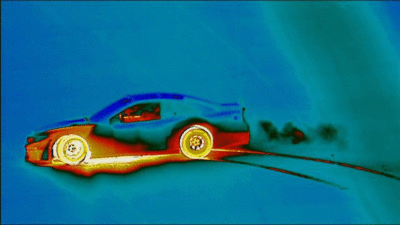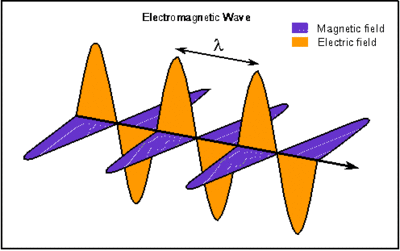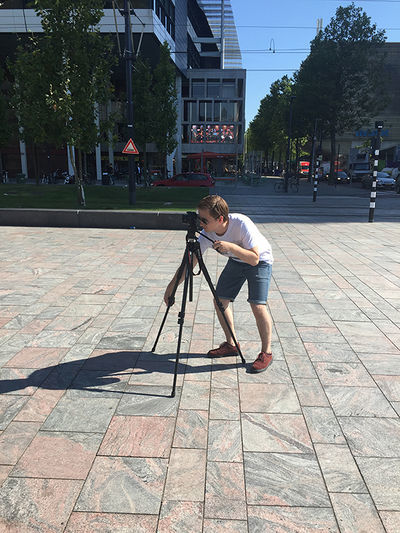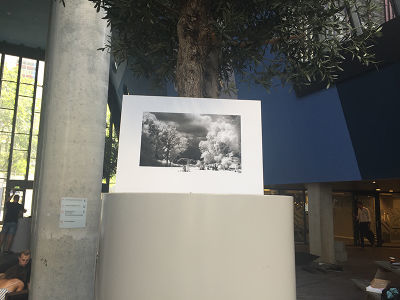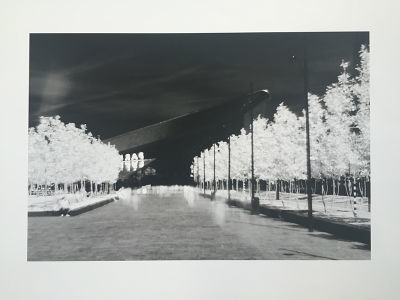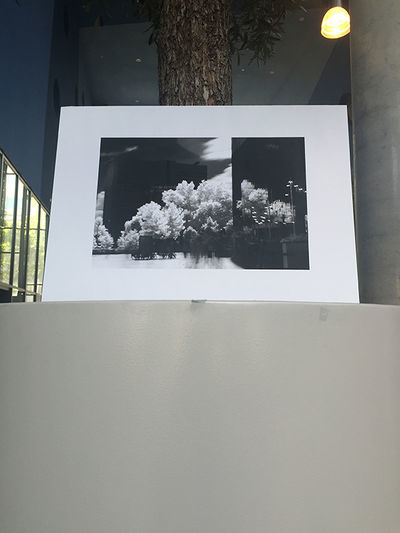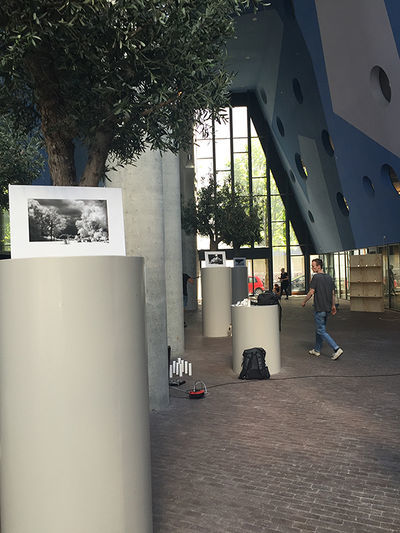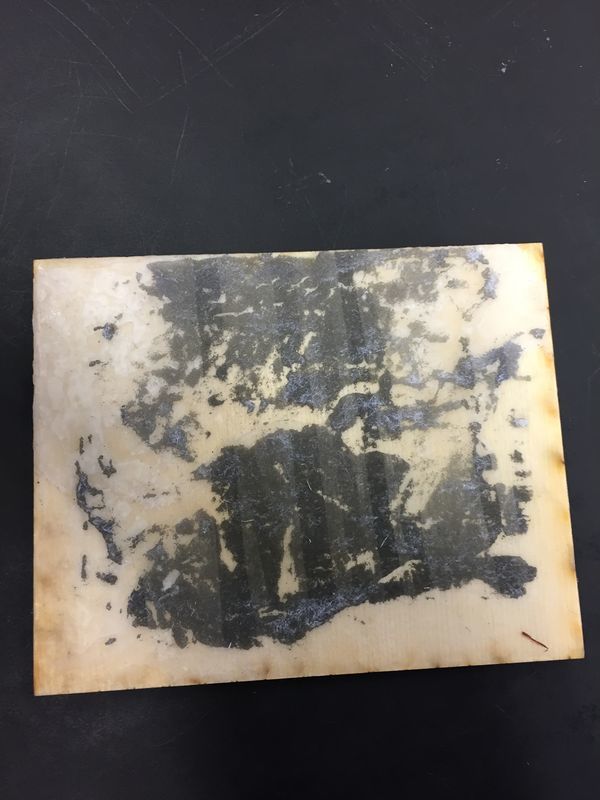Difference between revisions of "User:MarjoleinStassen/RADIATION"
| Line 164: | Line 164: | ||
Down below are my first tests with this. | Down below are my first tests with this. | ||
| + | |||
| + | |||
[[File:First layer.jpg | 600px ]] | [[File:First layer.jpg | 600px ]] | ||
Revision as of 12:45, 7 December 2016
Contents
RADIATION
KICK-OFF THERMAL RADIATION
Definition
- 1. PHYSICS
- the emission of energy as electromagnetic waves or as moving subatomic particles, especially high-energy particles which cause ionization.
- 2. BIOLOGY
- divergence out from a central point, in particular evolution from an ancestral animal or plant group into a variety of new forms.
- "evolution is a process of radiation not progression"
Intro
Thermal radiation is electromagnetic radiation generated by the thermal motion of charged particles in matter. All matter with a temperature greater than absolute zero emits thermal radiation. When the temperature of a body is greater than absolute zero, inter-atomic collisions cause the kinetic energy of the atoms or molecules to change. This results in charge-acceleration and/or dipole oscillation which produces electromagnetic radiation, and the wide spectrum of radiation reflects the wide spectrum of energies and accelerations that occur even at a single temperature.
Examples of thermal radiation include the visible light and infrared light emitted by an incandescent light bulb, the infrared radiation emitted by animals and detectable with an infrared camera, and the cosmic microwave background radiation. Thermal radiation is different from thermal convection and thermal conduction—a person near a raging bonfire feels radiant heating from the fire, even if the surrounding air is very cold.
Sunlight is part of thermal radiation generated by the hot plasma of the Sun. The Earth also emits thermal radiation, but at a much lower intensity and different spectral distribution (infrared rather than visible) because it is cooler. The Earth's absorption of solar radiation, followed by its outgoing thermal radiation are the two most important processes that determine the temperature and climate of the Earth.
Thermal radiation is one of the fundamental mechanisms of heat transfer.
Forms of electromagnetic radiation like radio waves, light waves or infrared (heat) waves make characteristic patterns as they travel through space. Each wave has a certain shape and length. The distance between peaks (high points) is called wavelength.
Links
- http://phys.org/news/2016-08-optical-material-unprecedented-thermal.html
- http://www.atomicarchive.com/Effects/effects7.shtml
- http://coolcosmos.ipac.caltech.edu/cosmic_classroom/light_lessons/thermal/transfer.html
- https://en.wikipedia.org/wiki/Yellowstone_Caldera
- https://en.wikipedia.org/wiki/Infrared
- http://coolcosmos.ipac.caltech.edu/cosmic_classroom/ir_tutorial/what_is_ir.html
- http://www.ipac.caltech.edu/outreach/Edu/Regions/irregions.html
- https://www.buzzfeed.com/simoncrerar/natural-phenomena-you-wont-believe-actually-exist?utm_term=.mkBAwoLwW#.ipz42q72e
- http://www.emlii.com/dd9b03c9/22-Ridiculously-Cool-Rare-Natural-Phenomena-That-Happen-on-Earth
- http://www.storypick.com/17-stunning-rare-natural-phenomena-occur-earth/
- http://inyminy.com/23-miraculously-awesome-rare-natural-phenomena-occur-earth/
- http://www.wired.com/2016/08/meghann-riepenhoff-littoral-drift/
- https://www.wired.com/2016/08/quickly-climate-change-accelerating-167-maps/
- http://www.wired.com/2016/08/conservation-big-problem-charismatic-carnivores/
- https://www.wired.com/video/2016/07/how-darpa-is-making-hacking-into-a-spectator-sport/
- https://www.wired.com/2016/08/heres-species-will-flee-global-warming/
- http://www.wired.com/2016/08/lightning-can-kill-300-reindeer-one-strike/
- https://www.behance.net/gallery/34555299/Irradi-ID
- https://www.behance.net/gallery/14740105/Tsunami-
Infrared
Infrared radiation is popularly known as "heat radiation"[citation needed], but light and electromagnetic waves of any frequency will heat surfaces that absorb them. Infrared light from the Sun accounts for 49%[20] of the heating of Earth, with the rest being caused by visible light that is absorbed then re-radiated at longer wavelengths. Visible light or ultraviolet-emitting lasers can char paper and incandescently hot objects emit visible radiation. Objects at room temperature will emit radiation concentrated mostly in the 8 to 25 µm band, but this is not distinct from the emission of visible light by incandescent objects and ultraviolet by even hotter objects (see black body and Wien's displacement law).
IR Advantages: Low power requirements: therefore ideal for laptops, telephones, personal digital assistants Low circuitry costs: $2-$5 for the entire coding/decoding circuitry Simple circuitry: no special or proprietary hardware is required, can be incorporated into the integrated circuit of a product Higher security: directionality of the beam helps ensure that data isn't leaked or spilled to nearby devices as it's transmitted Portable Few international regulatory constraints: IrDA (Infrared Data Association) functional devices will ideally be usable by international travelers, no matter where they may be High noise immunity: not as likely to have interference from signals from other devices
IR Disadvantages: Line of sight: transmitters and receivers must be almost directly aligned (i.e. able to see each other) to communicate Blocked by common materials: people, walls, plants, etc. can block transmission Short range: performance drops off with longer distances Light, weather sensitive: direct sunlight, rain, fog, dust, pollution can affect transmission Speed: data rate transmission is lower than typical wired transmission
- http://trace.wisc.edu/docs/ir_intro/ir_intro.htm
- http://www.space.com/33909-spitzer-space-telescope.html
- http://webbtelescope.org/webb_telescope/science_on_the_edge/beyond_the_visible/
- http://lonerwolf.com/things-we-cant-see/
- http://neutronsprotons.com/2015/06/05/the-top-10-things-we-cant-see/
- https://www.quora.com/What-if-there-are-things-that-we-cant-see-in-this-world
Statement: Just because we don't see it doesn't mean it doesn't exist. Our definition of seeing is incomplete.
Progress
ELECTROMAGNETIC RADIATION
- http://thecreatorsproject.vice.com/blog/who-knew-radio-waves-could-look-this-good
- http://radiator.ahoi.in
- http://thecreatorsproject.vice.com/blog/light-painting-visualizations-of-oslos-wifi-network
- http://thecreatorsproject.vice.com/blog/chernobyl-fukushima-radiation-lightmapping
- http://thecreatorsproject.vice.com/blog/what-cell-phone-signals-would-look-like-irl
- http://hackaday.com/2015/09/08/see-actual-microwaves-no-more-faking-it/
- http://www.physicsclassroom.com/class/waves/Lesson-4/Mathematics-of-Standing-Waves
LIGHT RADIATION
PATTERN RADIATION
- http://www.vasarely.com/site/site.htm
- https://en.wikipedia.org/wiki/Victor_Vasarely
- https://www.wired.com/2010/09/fractal-patterns-in-nature/
- http://discovermagazine.com/2001/nov/featpollock
- http://www.incendia.net/
- http://www.widewalls.ch/pattern-in-art/
- https://www.sophia.org/tutorials/design-in-art-repetition-pattern-and-rhythm
- http://www.astronwireless.com/topic-archives-antenna-radiation-patterns.asp
- http://www.cisco.com/c/en/us/products/collateral/wireless/aironet-antennas-accessories/prod_white_paper0900aecd806a1a3e.html
- http://growthobjects.com/?portfolio=high-complexity-natural-geometries
- http://growthobjects.com/?portfolio=rigi-workshop
- https://www.behance.net/gallery/41433927/Flight-School
- https://www.behance.net/gallery/23159731/Mcanotentology
- https://www.behance.net/gallery/17702797/EQUO-VALENS-CHRONICLES
- http://www.julius-horsthuis.com/
- https://www.behance.net/gallery/19782743/FRACTALIUS
- https://en.wikipedia.org/wiki/Patterns_in_nature
TOTEM
Written Assignment
1. What is your craft? (define your discipline, method or approach)
My one great passion and interest lies with nature. Nature is only the base which I like to expand on in which Digital Craft helps with that. It shows me possible new interests and passions. I'd like to use this minor to create a better understanding of what my craft specifically and not keep it so broad, since I feel like I keep searching every year. Perhaps the goal is to stop searching.
2. What are the tools and media of your craft?
I'd like to use exhibitions and installations to create that interaction with the public. This way perhaps more of a discussion can be evoked. The method of starting with a certain material or topic to find out what relates or is relevant to you as a person is a tool I'd like to use. My craft is currently very broad so most medias could be linked to my craft.
3. What are the borders of this practice? (what new media technologies have arisen / what is its future of the field))
I think most border are unexplored. I do see the future running on even more technologies and digital structures. Perhaps even more nature, which I love, are destroyed or ruined. Perhaps I could fight this destruction with the upcoming digital technologies. I find the digital worlds interesting but I love nature so perhaps the border is making a bridge between them.
4. Connect to a historical discourse and give concrete examples of contemporary practitioners.
The industry is dirtying more. i think there would be enough topics to focus on and bring more to the daylight. By doing this like to expose the relationship with man and nature or nature and machines. By doing this more environmental and urban issues, even ones from the past and how we are improving, could be addressed. There could some positivity connected to it instead of only tackling the 'heavy' world problems.
- http://www.dwbowen.com/
- http://nataliejeremijenko.com/
- https://en.wikipedia.org/wiki/Jean_Tinguely
- https://en.wikipedia.org/wiki/Arthur_Ganson
5. Define your position of your practice in relation to newer technologies.
We expect machines to run and water to flow, and yet it is in those moments when our expectations are not met that we truly see and appreciate the wonder in these everyday happenings. It’s in the moment of its interruption that we think to consider the simple elegance of a wave’s movement. In some ways the devices are attempting, often futilely, to simulate or mimic a natural form, system or function. When the mechanisms fail to replicate the natural system the result is a completely unique outcome. It is these unpredictable occurrences that I find most fascinating.
HEAT RADIATION
Heat radiation becomes a bigger aspect of our lives. Biotopes across the world melt while others dry out. All of this is happening because humans are breaking down the protective shield around the earth, making the effects of heat radiation even worse. With this project I will use heat radiation as a tool to tell my a layered story about this former topic.
Down below are my first tests with this.
